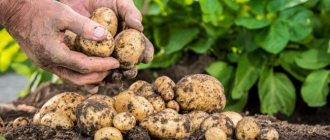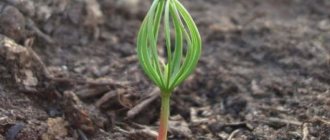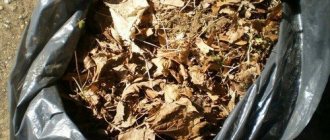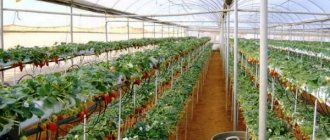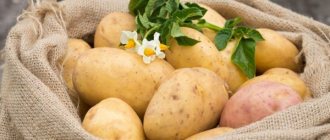Potatoes can be grown in a regular bag with minimal space, time and effort. As a rule, this method of planting is resorted to by gardeners who have very little space for future crops, infertile soil or unsuitable conditions in the garden bed in the form of swampiness, rockiness, etc. What is the essence of the method, and how to grow potatoes in this way, let’s find out Further.
The essence of the method
The principle of this method is to plant potatoes in bags in which the bushes will grow. As a rule, it is used in small gardens or summer cottages where there is infertile soil.
In this case, there are three key conditions for obtaining a good harvest. They look like this:
- provide the potatoes with a loose nutrient medium so that they can grow healthy and strong;
- water the plant abundantly;
- maintain good lighting.
Another important point in this method is the location of the bags of potatoes. They can be dug a little into the ground or installed near a support. In any case, the plant must be well lit, accessible for care, and not exposed to wastewater from the roof.
The implementation diagram of this method looks like this:
Technology for growing potatoes in bags: rules, recommendations and instructions with photos and videos
Preparing bags
Potatoes can be planted in different bags.
Advice! Some even use thick garbage bags for this.
It is not necessary to buy new bags; you can use old ones. The main thing is that there are no large holes in them from which soil will spill out.
White bags are best used in the southern regions of the country. In them the earth will heat up less.
Important! Old bags must be thoroughly cleaned before use.
It is very convenient to plant potatoes in special bags designed specifically for this method. However, they are difficult to find for sale in small towns and villages. Besides, they are expensive.
But black plastic bags can be bought at any hardware store, and they are inexpensive.
You can also use luggage bags, which almost everyone has. They are also sometimes called “shuttle”. In such a bag you can create a small potato bed.
Important! The bags should have holes to ventilate the roots and remove excess water.
Soil preparation
It is necessary to use nutritious and light soil. In heavy clay soil it will be difficult for tubers to develop.
Important! To plant potatoes in bags in February-March in the northern regions of the country, the soil must be prepared in the fall, since in early spring the ground is still frozen.
Composition of soil mixture for filling bags:
- 1 bucket of fertile soil from the garden.
- 1 bucket of humus;
- 2-3 liters cans of coarse sand.
- 1-2 liters cans of wood ash.
Mix all ingredients well and remove any stones and branches.
Important! You cannot take soil from an area where nightshades previously grew.
What varieties are suitable
For planting in bags, it is better to use large-fruited and easy-to-care potato varieties. Suitable for this:
- Bellarosa (Bella rose) (Germany);
- Sante (Netherlands);
- Svitanok Kyiv, Slavyanka, (domestic).
Attention! It is necessary to choose early varieties that give a rich harvest.
What bags should I use?
Planting containers can be very different. More often, gardeners use bags with “pockets” for selecting potatoes, but ordinary ones made from synthetic fibers, for example, from sugar or flour, are also suitable. The most important thing is that the container has holes through which excess moisture will evaporate. If they are not provided, then there is a high probability that the tubers will rot during their development.
The containers chosen should not be too deep, as the plant may not have enough moisture and strength to grow and form new potatoes.
You should not use regular garbage bags for planting potatoes, as they are less durable than their counterparts and can tear when caring for potatoes.
Optimal growing conditions
To cultivate potatoes, you need to choose a well-lit place with convenient approaches to it for caring for plants and harvesting. The bags must be installed firmly, not tilt or sag.
To ensure stability, they are buried in the ground or reinforced with supports (bars, bricks). It is also necessary to take into account that excess water after watering will flow out of such a container and flood the area around it.
Important! You should not place bags with crops under drains - during the rainy season they can be flooded, which will lead to rotting of the root crops.
Variety selection
The most suitable are mid-early and early varieties, as well as potatoes with an average ripening period, which are highly resistant to various diseases. Unlike later varieties, early varieties ripen faster, so the time required to care for the plantation is reduced.
Here are the most popular options:
- Bellarosa is an ultra-early ripening variety of German selection that bears fruit with large and even pink tubers;
- Sante is a mid-early variety of Dutch selection that bears yellow root crops 2.5-3 months after planting;
- Slavyanka is also a mid-early variety, but of Ukrainian selection, which ripens 3-3.5 months after planting;
- Povin - is an early ripening variety of Ukrainian selection, which ripens by mid-June - early August, the fruits weigh up to 200 g;
- Svitanok Kiev is one of the mid-early varieties of Kyiv selection, which has excellent commercial qualities and is characterized by high yield in any climatic conditions.
Many of the listed varieties allow you to get the first harvest by the end of May.
Early ripening potato variety "Bellarose"
Mid-early potato variety "Sante"
Potato variety “Slavyanka”
Early ripening potato variety "Povin"
Mid-early potato variety “Svitanok Kievskiy”
Necessary materials for growing
For this potato growing technology, it is necessary to prepare three main components:
- Taru. To do this, they use durable and spacious bags, at the bottom of which some gardeners sew a valve with their own hands for harvesting. There are special bags for this technology. You can use polypropylene products - they allow air and moisture to pass through, are strong and resistant to high humidity. 50 kg bags of sugar, flour or cereal, as well as shuttle bags, work well. Some gardeners manage to use garbage bags for these purposes. You should not take items that are too long or dense for planting.
- Substrate. It must be nutritious, allow water and air to pass through well, and be disinfected.
- Tubers for planting. You should focus on early varieties with high yields that produce a large number of tubers. You can use planting material with medium ripening periods.
Preparation of planting material
For sowing, you need to select the most powerful and healthy tubers, which need to be disinfected and left for germination. So, 2-3 weeks before planting, you should do the following:
- Pass several peeled cloves of garlic through a press and add cold water at the rate of 10 liters of water per 1 kg of garlic.
- Mix everything and leave for 2 hours.
- Soak the tubers in the resulting infusion for 5 hours. It is important that the solution completely covers the potatoes.
- After processing, place the tubers in a well-ventilated, bright place and leave for germination. The optimal air temperature is +14…+18 degrees. When sprouts 2-5 cm long appear, you can start planting. Tubers that have not sprouted should be immediately discarded, as they will not bear a good harvest.
Treating tubers with garlic solution will protect planting material from diseases and also stimulate plant growth.
Diseases and pests of potatoes when grown in bags
It is necessary to frequently inspect growing potato bushes in order to immediately detect emerging pests. In addition to the long-familiar Colorado potato beetle, different types of mites and aphids may appear on them. But with this technology, potatoes are almost untouched by pests and diseases, but ants are annoying.
How to rid potato bags of ants
Ants love warm places and constantly try to make their home in a greenhouse, a wooden box, and even climb under cut plastic bottles that protect seedlings in the garden. Bags exposed to the sun will be a good home for these insects. Lots of ants will ruin the fun you can get from growing potatoes. It is difficult to remove these residents, for this reason it is advisable to carry out preventive measures:
- Sprinkle the space near the bags with ant poison, for example, Anteater is suitable.
- Sprinkle the soil in bags with dry mustard or ground pepper.
- Move and water the “container” more often; it is necessary to disturb the first ants that appear as often as possible.
Substrate preparation
You need to start preparing the soil in the fall, but it is important to take into account that land on which nightshade crops previously grew, including tobacco, eggplant, tomatoes, peppers, etc., is not suitable. This is a necessary measure to protect the crop from late blight, as well as other diseases and their pathogens. In addition, you cannot take the land where the mole cricket lives.
Suitable soil must be weeded, steamed or treated with chemicals so that later weeds and pests do not penetrate into the bags, which will be difficult to remove in confined spaces.
Potatoes in bags need more nutrients than tubers growing in open ground. So, you should prepare one of the following soil mixtures:
- Garden soil and compost (humus) . They are taken in equal parts. Fallen leaves, manure, sawdust or dust can be used as compost, and the soil can be black soil, yellow sand, or a small amount of clay to retain moisture.
- Land and fertilizers . It is necessary to mix humus soil with potassium and phosphorus fertilizers. To maintain optimal proportions, add 0.25 cups of complex fertilizer to one bag (about 4 buckets of soil). It is important to note that if pure humus is used, which was taken from a manure or compost heap, then there is no need to use minerals.
You can also use ordinary soil without additives in the form of humus or fertilizers, but in this case the yield will suffer significantly.
It is worth considering that when forming a soil mixture, special attention should be paid to its looseness and breathability. To do this, before putting it into bags, the soil must be sifted, and solid fractions, roots of weeds and pests such as wireworms and mole crickets must be removed. Thanks to these simple steps you can get beautiful, smooth root vegetables.
Preparing for landing
According to this original technology, you will need containers - bags and a substrate for filling them. They must meet certain requirements.
Bag selection
Potato bags must be spacious and durable in order to withstand the weight of the substrate and not rot before the end of growing. For these reasons, fabric and paper are not suitable.
But you can use either special bags or take synthetic wicker ones, for example, for flour or sugar - they are quite strong, air- and moisture-permeable, so there is no need for drainage. Solid thick bags made of polypropylene will also work, but in order for air to flow into them and excess water to drain out, you need to pierce holes in them around the entire perimeter.
Preparation and preparation of earthen mixture
Due to the fact that the feeding area for potatoes in bags is small, the soil in them should always be fertile. For city residents who want to grow potatoes on the balcony, the only option is to buy ready-made soil mixture in the store. For those who have a dacha or personal plot, there is another way - to prepare the mixture yourself from garden soil along with humus in a 1 to 1 ratio, fertilized with a glass of ash. After this, the substrate must be spilled with potassium permanganate to disinfect and dry.
We recommend reading
Optimal timing for planting potatoes in different regions
Review of various potato planting schemes: what depth to plant, distances
Technology for planting potatoes under a shovel: planting scheme, care
Instructions for use of the drug Taboo for the Colorado potato beetle
Which potato varieties to choose
Not all varieties are suitable for growing in bags. It is clear that it would be advisable to choose early-ripening, large-fruited varieties; Such potatoes can be obtained quickly and you can hope for a harvest even with not very diligent care. Other characteristics of potatoes, such as skin and pulp color, friability, are left to the discretion of the vegetable grower.
Planting time and technology
Potatoes need to be planted with the arrival of stable heat. In many regions with a temperate climate, this time comes at the end of April or early May.
The planting of the prepared tubers is carried out in the following order:
- Fill the bottom of the bag with loose soil mixture. Depending on the total depth of the future bed, such a layer can have a height of 20 to 35 cm.
- Place 4-5 potatoes or slices with sprouted eyes on the soil surface.
- Cover the potatoes with soil mixture to a height of 15 cm.
- If necessary, water the plants lightly. After 8-15 days, sprouts will appear. When they rise 10-15 cm above the soil level, add a new portion of the mixture to promote the formation of additional lateral roots on which new tubers will grow. Only the tops of the shoots should remain on the surface.
- Carry out the procedure of sprinkling the seedlings until one third of the total height remains to the top edge of the bag.
Sequencing
First of all, you need to wait for the onset of warm days, when the danger of return frosts has already passed. For temperate regions, this period begins in late April or early May. It is also important to know the basic nuances of cultivating crops for the region in order to grow a good harvest. If the summer resident has the opportunity to keep the bags indoors, then he should plant the potatoes earlier. The sequence of actions will be as follows:
- As soon as the planting time has arrived, place a layer of nutritious soil of a loose structure on the bottom of the bags. The mixture should contain more humus than garden soil. The soil layer is calculated based on the depth of the planting container. Usually it is 10 cm...35 cm.
- Place pre-selected tubers on top of the layer. Healthy medium-sized specimens are selected for cultivation. Some gardeners use parts of potatoes with eyes.
- Cover with a layer of light, loose soil about 15 cm thick.
- Moisten the “bed”.
The first shoots appear after 10-14 days. It is necessary to monitor the condition of the soil and water the seedlings on time. When the height of the stems reaches 10 -15 cm, add soil to the level of the first leaves. The agricultural technique forces the potatoes to form new roots, on which additional tubers will form.
Repeat adding soil several times. The soil layer should not be more than 2/3 of the height of the bag. It should not be made higher, otherwise the potatoes will not have enough strength to form a crop. The entire supply of energy and nutrients will be spent on the growth of tops. This is the main mistake that potato growers make when growing crops in bags.
Care
The most important procedure is watering. Moisture from the bags evaporates more than when growing in soil. Therefore, you will have to water the potatoes on a different schedule - more abundantly and more often. The main attention should be paid to the period of flowering and tuber formation. Vegetable growers advise watering the garden bed so that all the soil is moistened. This raises one difficulty. It is necessary to ensure good water flow to avoid stagnation, and air access for ventilation. It is most convenient to make small cuts at the bottom of the bag and a valve for removing the tubers before planting. This option is only suitable for bags made of dense material. Thinner material can be pierced with an awl.
Potatoes grown in bags need feeding in moderation. In addition, you should not get carried away with nitrogen fertilizers, which stimulate the growth of green mass and prevent the formation of a dense peel. It is more useful to add potassium sulfate and a little superphosphate. This will improve the quality of potatoes and their yield. Fertilizing must be combined with watering.
When the tops begin to turn yellow, the potatoes are ready for harvest. The time depends on the ripening period of the variety. With a good agricultural background, up to 5 kg can be harvested from 1 bag, this is provided that 4-5 tubers are planted.
How to care?
To get a good potato harvest, you should take proper care of your planting. To do this, you need to pay attention to the following points:
- Location of bags . They should be located on the sunny side of the site, since this can ensure good heating of the plant and achieve faster germination. The bags can be kept under the walls of buildings, along paths, between trees or in flower beds. Another option is to place them around the perimeter of the site if you do not plan to plant anything. The most important thing is to ensure their stability so that they do not fall on their side. If there is no support, the containers should be slightly buried. Under no circumstances should bags be kept in dense shade or under a drain.
It is better if the covering under the plant is able to absorb excess moisture that drains after watering.
- Watering . In bags, moisture evaporates very quickly, so potatoes require abundant and frequent watering, especially during the flowering period, when the first tubers appear. Of course, you also cannot overdo it, otherwise it will negatively affect the harvest. There is no need to water the plant before the first shoots form. After the emergence of seedlings, you need to wait 3-4 days and start watering. The daily water requirement is 2-3 liters, but in dry weather.
- Feeding . Once a season, potassium and phosphorus fertilizer should be applied to maintain the yield and quality of tubers. The preparations must be diluted according to the instructions and applied in liquid form at the rate of 1 liter per 1 bush. At the same time, the abundance of nitrates and nitrogen is unacceptable, since they inhibit the growth of tubers and deteriorate their quality.
- Make a flap pocket at the bottom of the bag . It will greatly facilitate the removal of tubers, and will also provide additional ventilation of the root system. Its advantage also lies in the fact that you can get ripened potatoes from below without disturbing the upper layer, where the tubers are still younger and smaller.
Care
Now planting requires only watering. Moreover, you need to remember that due to greater evaporation of moisture than in the soil, you will have to water the potato plantings in bags more often and more abundantly. Water is especially important during flowering, when the first tubers begin to form.
Experienced gardeners who have experience using this technology focus on the benefits of abundant watering, soaking all layers of soil in the bag.
It is the access of air and the drainage of excess water that often becomes a problem when growing potatoes in bags.
- If the material from which the container is made is dense enough, it is better to make small cuts at the bottom of the container before planting.
- A special valve at the bottom of the bag or bag greatly facilitates the removal of tubers and ventilation of the root system.
If we talk about feeding plantings, then moderate use of potassium fertilizers when growing potatoes in bags has a beneficial effect on the yield and quality of tubers. But it is better to refrain from using an abundance of nitrogen in fertilizing, since in this case the tubers do not ripen for a long time and do not form a strong peel, which will not make it possible to store the potatoes.
Harvesting with this technology occurs in the second half of August. And if favorable conditions are created, up to 5 kg of quality products can be obtained from 4–5 planted tubers.
Harvesting
As a rule, it is produced in the second half of August in two ways:
- Turn the bag on its side and pour the potatoes out.
- If the bags had pocket flaps, open them and remove the potatoes. Of course, if you no longer plan to use the bags, you can simply cut them and empty the potatoes with ease.
Experienced gardeners harvest up to 5 kg of potatoes from one “bed”. So, from 5 planted tubers you can get about 10 kg of harvest.
After harvesting, the entire bags can be folded and used again next year.
Further care
Caring for the crop when using this method is simple - just water and feed the plants correctly. By following all the recommendations, you can increase the yield by 2-3 times.
Top dressing
Fertilizers are applied three times per season:
- when the tops reach a height of 20 cm;
- during the budding period;
- during flowering.
To feed potatoes, use bird droppings or mullein diluted in water (proportions 1:10) and potash fertilizers.
Reference. Nitrogen fertilizers are not used because they stimulate the development of green mass, which negatively affects the ripening of tubers.
Top dressing is applied at the root so that the solution does not get on the stem and leaves.
Watering mode
On average, plants are watered once every 7-10 days at the rate of 2.5-3 liters of water per bush. Watering is stopped 15-20 days before harvesting.
Protection from diseases and pests
The risk of developing diseases with this method of cultivating potatoes is minimal . However, you will need to regularly inspect the bushes and, at the first signs of any diseases, treat the plants with fungicidal preparations, for example, Alirin-B or Fitosporin-M.
For potatoes grown in bags, the most dangerous pest is ants. To prevent their appearance, mustard, pepper or “anteater” type poison are scattered around the bags.
Recommendations and nuances
Additionally, the following points should be taken into account:
- Unlike the classical method, this method requires more frequent and abundant watering.
- Throughout the growth of the plant, you need to cover the bush with soil, leaving only the top leaves on the surface. At the same time, a powerful root system is formed, on which new potatoes begin to grow.
- The largest potatoes will grow at the bottom of the bag. So, the closer to the surface, the younger the tubers. This is due to the fact that it initially grows from planted tubers closer to the bottom.
- If the container is made of dense fabric, it is worth making several small cuts on its bottom and sides before planting. In this case, it is possible to ensure the evaporation of excess moisture, which will protect the potatoes from rot.
- After harvesting, the soil loses all its beneficial properties and therefore cannot be reused. It needs to be spread over the garden bed as mulch.
Features of caring for potatoes in bags
The technology of growing potatoes in bags and caring for them requires special attention. However, the principle of caring for plants is simple: you need to water the plantings, feed them, and loosen the soil. More detailed instructions:
- Regularly monitor the condition of the soil (even if using mulch). It should be moist, but not soggy.
- For irrigation, it is advisable to use settled and heated water.
- After the emergence of shoots up to 15 cm long, you need to fertilize and fill them halfway with fertile soil (repeat similar work after another 12-14 days).
- After the rudiments of the buds appear, you need to add soil one last time. The maximum soil layer by this period should be no more than 0.6 m.
When the potato tops begin to turn yellow, you can harvest.
Watering
Due to greater evaporation of moisture than when growing plants in the garden, you need to water the potatoes more often. This is especially important during flowering, when the first tubers begin to form.
Expert opinion
Filatov Ivan Yurievich, private farmer for more than 30 years
According to experienced gardeners who use this particular technique, the most beneficial for potatoes is abundant watering, soaking all layers in the bag. But in the absence of holes for removing excess moisture, this can lead to stagnation of the liquid and, as a result, the death of the crop.
Feeding
All fertilizing of potatoes should be done after watering. In addition, after carrying out the activities, give the plants a short shower to wash away additives and fertilizers from the leaves and surface of the soil.
For potatoes grown in bags, it is best to use:
- "Green" fertilizer . For this fertilizer you need to use any suitable greens: burdock, nettle, celandine. Moreover, you need to use roots with soil - bacteria are needed in the mass. Place everything in a large container, fill with water and leave to infuse for two weeks, stirring. Fertilizer can be used when only coarse parts of the weed remain; the mass itself should smell unpleasant. To prepare the fertilizer, take 2 liters of the mixture, add 8 liters of water and start watering.
- Infusion of bird droppings : fill 10 liters of water with 20% droppings, add water, leave for a week. In another container, prepare a solution: 500 ml of mixture, water. You can also use mullein infusion, which is prepared in a similar way.
It is worth using ash for fertilizing, which is added a week after fertilizing with organic matter. You just need to pour 100 g of ash into a bag and carefully loosen the soil.
Advantages and disadvantages
Growing potatoes in bags is a container planting method that has its advantages and disadvantages. We will consider them further.
What is the strength?
- significant space savings, because a bag of potatoes can be kept both on the path and near the house, the main thing is to provide good lighting;
- unpretentious care, since potatoes in containers do not need to be hilled up, but simply adding more soil as the plant grows;
- there is no need to weed out weeds, because they will have nowhere to come from in a closed space;
- complete protection against the Colorado potato beetle, late blight and wireworm, which have to be combated when planting tubers in open ground;
- minimal risk of rot, since water does not stagnate in the bag, and the soil warms up well;
- quick harvesting, since the potatoes do not need to be dug up, but simply turn over or cut the bag to collect dry and clean potatoes.
What's wrong?
- quick drying of soil in bags;
- the need to use a large amount of nutrient soil or prepare a soil mixture;
- bushes ripen quite quickly, so it is extremely important to maintain all conditions for the formation of full-fledged tubers.
Growing technology
You don't need a hectare of land to grow potatoes. Growing your own can bring many benefits. To start growing potatoes, all you need is a bag, a box, or a cardboard box.
Interesting fact! Potatoes do not have to be grown in the ground; you can plant them in straw.
Selection of packaging - bags, boxes
To organize the cultivation you will need bags (ordinary white polyethylene bags made of polypropylene fiber, sold in any garden store). It is important that the bags are not dark and do not heat up from the sun's rays. Sometimes dark or colored bags are used, in this case you need to carefully ensure that the soil does not dry out under the sun.
Photo. Bags for growing potatoes
Similarly, you can grow potatoes using old tires. When the bush grows, put the second and third tires on top, adding soil. The same method is used for tomatoes.
Gardeners also use boxes and buckets.
It is important to choose a good variety; it is better to give preference to early varieties.
Comparison with planting in barrels and boxes
Potatoes are planted in barrels according to their diameter, and in boxes in a checkerboard pattern (read about how to grow potatoes in boxes and boxes without a bottom here). Potatoes planted in barrels require sufficient oxygen, but often this is not enough due to the small holes. You should also understand that it is much more difficult to make a hole in a barrel than in a bag. In addition, you need to knock out the bottom of the barrel. Therefore, it is easier and more convenient to grow potatoes in bags. The only advantage of barrels is their stability, unlike bags.
As for boxes, it is more convenient to grow in them than in barrels. They are stable and easier to move. The sun's rays penetrate evenly into the soil, but this is also a disadvantage, since the moisture will leave faster.
